|
|
|
Sort Order |
|
|
|
Items / Page
|
|
|
|
|
|
|
| Srl | Item |
| 1 |
ID:
125600
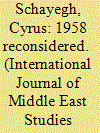

|
|
|
|
|
| Publication |
2013.
|
| Summary/Abstract |
Using Arabic, English, and French sources, and engaging Middle East and Cold War historians, this article makes a threefold argument. First, in United Arab Republic (UAR)-Syria, Jordan, and Lebanon, the 1958-59 explosion of domestic and regional tensions triggered state-formation surges. Second, these formed one process, which made those states more alike, with state-led socioeconomic planning playing a key role. Third, that process partook of a global Third World trend intersecting with the early Cold War. I draw three conclusions. Although existing scholarly readings that the events of 1958-59 in the Arab Middle East formed a crisis but not an ideological or political watershed are correct, from the viewpoint of state formation this crisis was a milestone. Moreover, UAR-Syria, Jordan, and Lebanon had persisting affinities and shared regional positions-notably, the fact that all were sandwiched between the unstable poles of the Arab state system, Iraq and Egypt-that shaped their individual postindependence histories of state formation. Last, Washington's low-profile involvement in this state-formation surge illustrates how domestic sociopolitics and regional geopolitics-including the UAR's peaking popularity and influence in 1958-59-affected U.S. policy in the Cold War postcolonial world.
|
|
|
|
|
|
|
|
|
|
|
|
|
|
|
|
| 2 |
ID:
125621
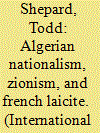

|
|
|
|
|
| Publication |
2013.
|
| Summary/Abstract |
The Algerian war resituated the meaning of "Muslims" and "Jews" in France in relation to religion and "origins" and this process reshaped French secular nationhood, with Algerian independence in mid-1962 crystallizing a complex and shifting debate that took shape in the interwar period and blossomed between 1945 and 1962. In its failed efforts to keep all Algerians French, the French government responded to both Algerian nationalism and, as is less known, Zionism, and did so with policies that took seriously, rather than rejected, the so-called ethnoreligious arguments that they embraced-and that, according to existing scholarship, have always been anathema to French laïcité. Most scholars on France continue to presume that its history is national or wholly "European." Yet paying attention to this transnational confrontation, driven by claims from Algeria and Israel, emphasizes the crucial roles of North African and Mediterranean developments in the making of contemporary France.
|
|
|
|
|
|
|
|
|
|
|
|
|
|
|
|
| 3 |
ID:
125685
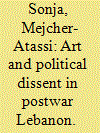

|
|
|
|
|
| Publication |
2013.
|
| Summary/Abstract |
Taking Walid Sadek's fi annani akbar min bikasu [bigger than picasso] as its starting point, this article examines relations of art and politics in post-civil war Lebanon. A tiny and inexpensive paperback related to Picasso unfolds into a work of art that raises questions about the place of art and political dissent. After situating bigger than picasso in the context of contemporary book art and artistic practices of the postwar generation in Lebanon, the article focuses on the juxtaposition of text and image. By placing narratives of art vandalism next to the image of a monument dedicated to the late Syrian President Hafiz al-Asad, bigger than picasso playfully and provocatively breaks with political taboos at a time when the silence about the Lebanese Civil War (1975-90) and about Lebanese-Syrian relations was met with increasing anxiety. At the same time, the work makes room for aesthetic inquiries, exploring new possibilities of art at the margins of cultural production. The article concludes that bigger than picasso brings to the fore the discrepancy between public monumentality and artistic practices, which in finding ways around political violence and censorship have recourse to ephemeral and private spheres, and holds unexpected meanings in ever-changing political circumstances.
|
|
|
|
|
|
|
|
|
|
|
|
|
|
|
|
| 4 |
ID:
125666
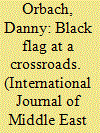

|
|
|
|
|
| Publication |
2013.
|
| Summary/Abstract |
A political trial, according to Steven E. Barkan, is a trial revolving around highly publicized legal controversies. In some cases, such a trial may determine fundamental political questions, exceeding the legal realm, which are in debate inside a given polity. The 1957-58 trial related to the 1956 massacre in Kafr Qasim, Israel certainly belongs to this category. The trial established the doctrine of a "manifestly unlawful order" in Israeli military law, contributed considerably to the reshaping of civil-military relations, and influenced the civic status of the Arab minority in Israel. In this article, using hitherto underexamined primary sources, I argue that the most important contribution of the trial, the doctrine of a "manifestly unlawful order," was not only a creation of the bench but also a result of a complicated interaction between the actors present in the courtroom: the defendants, their defense lawyers, the prosecutors, and the judges. Above all, the article shows how the bitter struggle between the two main attorneys helped shape the doctrine of a "manifestly unlawful order," that is, an order that is illegal for a soldier to obey.
|
|
|
|
|
|
|
|
|
|
|
|
|
|
|
|
| 5 |
ID:
125665
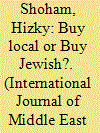

|
|
|
|
|
| Publication |
2013.
|
| Summary/Abstract |
The article explores the Zionist cultural economy in interwar Palestine, by studying the emergence of the field of consumption as an arena for political struggles among Jews and between Jews and Arabs. The Jewish nationalist movement employed dominant contemporary assumptions about economic nationalism in attempts to politicize the economy of British Palestine, including through campaigns advocating ethnonational separatism in consumption. Unlike other "buy local" movements around the world, these were not directed solely against imports; rather, they were often "buy Jewish" campaigns waged against the consumption of commodities produced by the rival ethnonational sector in Palestine. Using a variety of archival and media sources, the article tracks the development of Jewish separatist consumption campaigns in interwar Palestine, uncovering a gradual amplification of their ethnonational emphasis that paralleled the escalation of the Arab-Jewish conflict. The cultural mechanisms used to attribute ethnic qualities to objects and define them as either "Jewish" or "foreign" are analyzed with particular attention to the conceptual contradictions in the definitions of a Jewish product, which were shaped by economic conflicts and the diverse political conceptions of Jewish identity. The study of separatist consumption sheds new light on the "dual society" thesis, revealing the deep grip of separatist approaches across multiple layers of the Jewish middle class in the Yishuv.
|
|
|
|
|
|
|
|
|
|
|
|
|
|
|
|
| 6 |
ID:
125668


|
|
|
|
|
| Publication |
2013.
|
| Summary/Abstract |
This article examines the depiction of women and gender within Coptic Orthodox video films or "hagiopics" produced between 1987 and 2010. As part of a recent religious renewal, hagiopics have expanded, altered, and reinvented traditional stories of saints and pious figures and have also generated, within this traditionally patriarchal setting, a wider space for the articulation of female voices. While their inclusion can be seen as potentially empowering for women, this paper suggests that during Pope Shenouda III's reign (1971-2012), the films became a powerful vehicle for broadcasting the church's conservative teachings on female power and authority, marriage and marital dissolution, spousal abuse, and femininity. By highlighting an array of exemplary female characters, hagiopics capture women's role as custodians of a distinctive Coptic ethos and of family and communal cohesiveness. The films' emphasis on women's physical modesty, submissiveness, and obedience to male figureheads also hints at the modern church's anxieties about women's increasing autonomy in choosing marriage partners and their growing demands for more equal treatment within the church.
|
|
|
|
|
|
|
|
|
|
|
|
|
|
|
|
|
|
|
|
|